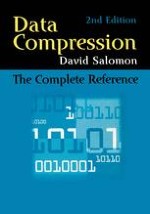viii • The second new chapter, Chapter 6, discusses video compression. The chapter opens with a general description of CRT operation and basic analog and digital video concepts. It continues with a general discussion of video compression, and it concludes with a description of MPEG-1 and H.261. • Audio compression is the topic of the third new chapter, Chapter 7. The first topic in this chapter is the properties of the human audible system and how they can be exploited to achieve lossy audio compression. A discussion of a few simple audio compression methods follows, and the chapter concludes with a description of the three audio layers of MPEG-1, including the very popular mp3 format. Other new material consists of the following: • Conditional image RLE (Section 1.4.2). • Scalar quantization (Section 1.6). • The QM coder used in JPEG, JPEG 2000, and JBIG is now included in Sec tion 2.16. • Context-tree weighting is discussed in Section 2.19. Its extension to lossless image compression is the topic of Section 4.24. • Section 3.4 discusses a sliding buffer method called repetition times. • The troublesome issue of patents is now also included (Section 3.25). • The relatively unknown Gray codes are discussed in Section 4.2.1, in connection with image compression. • Section 4.3 discusses intuitive methods for image compression, such as subs- pling and vector quantization.
